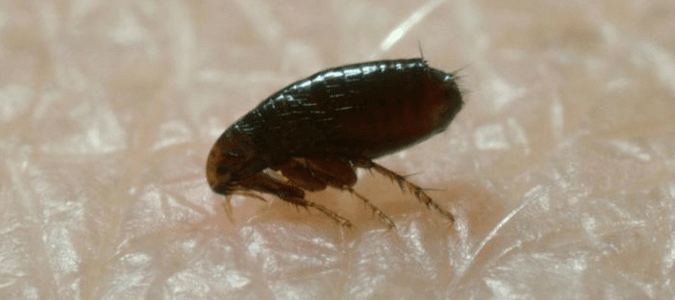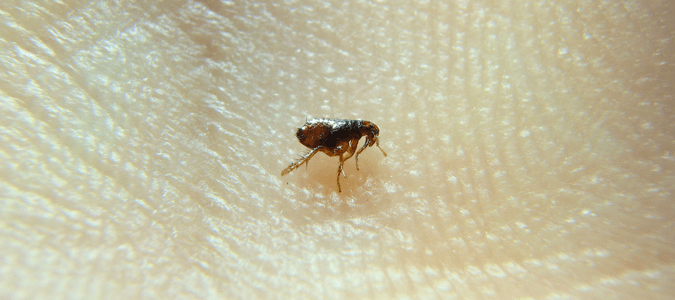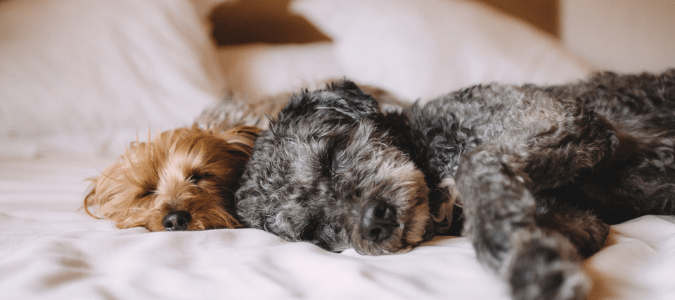If you have furry pets long enough, you will likely encounter fleas. Fleas are incredibly well adapted to living with humans, and the odds are they will find you and your pets at some point.
Your pets can get fleas even if they never leave the house. Fleas are very well adapted to living with us and can come in from outside by various methods:
- They can hitch a ride inside on pets or rodents.
- They can hop in through an open door or window.
- They can come inside through air ducts or unsealed cracks.
- They can come in on used clothing or upholstered furniture.
Flea Larvae
Fleas follow a typical life cycle. Flea eggs hatch as worm-like larvae an eighth to a quarter of an inch long after one or two weeks. They’re actually more extensive as larvae than adult fleas. The larvae are whitish and often have brown heads. You’ve probably never noticed flea larvae before, even if you’ve dealt with flea infestations.
When the larvae hatch, they head downward. They crawl under the carpet if they can, under cushions, and into cracks and crevices. The larvae want dark, cozy surroundings to feed on droppings from adult fleas (known as “flea dirt”). That’s their food during the larval stage. It’s composed of partially digested blood from a host. They stay hidden, feasting on the “dirt” that drops from the host whenever it’s overhead, for a week or two. After that, they spin a cocoon and pupate.
Since flea larvae are tiny and they hide, most people never see flea larvae. They want low humidity since moisture will dissolve their food source, and rain can drown them if they’re outside. Flea larvae want the same temperature range people enjoy.
From Larvae to Pupae
Flea larvae are vulnerable pests. They’re soft and slow, making them easy targets—if you can find them. The transition from soft to complex begins when the flea larvae pupate into their adult form.
Flea larvae spin themselves into tiny little cocoons that are about as hard to find as the larvae. These cocoons start white but rapidly pick up coloring from the flea dirt falling on them and blend into their environment. In an environment with warm temperatures, humidity, and host animals around, a flea will take about a week to pupate into an adult.
Contacting a professional pest control expert is the best way to deal with a flea infestation. A pro knows what fleas look like, how to look for fleas in all life cycle stages, and how to control them.
Where Do Fleas Lay Their Eggs?
Fleas emerge from the cocoons as fully formed adults. Their exoskeletons are tough, and their ability to jump is impressive. Fleas can quickly jump six inches.
A female flea will lay about 50 eggs per day. Fleas can live up to a year, and a single flea can lay 1,500 eggs during her lifetime. She lays them on the host she feeds on, but the eggs are not sticky. They tend to fall off into the environment. Bedding, mattresses, fabric toys, furniture cushions, favorite holes in the backyard–wherever your pets spend a lot of time will become flea nurseries.
Fleas are never easy to address, but the time to start is as soon as you realize you have a problem. Please don’t assume you can do it all yourself. Rely on pest control professionals to take care of a flea infestation.
How to Identify Flea Eggs and Other Signs of Infestation
Flea eggs are about the size of a grain of salt. Many people think the eggs are dark brown specks, just like the flea dirt, but flea eggs are white. They’re about the same size as flea dirt but look nothing alike. Any place your pet spends time–beds, cat towers, and favorite holes in the backyard—rapidly becomes littered with flea dirt and eggs. And since the pet likes that spot, freshly hatched fleas don’t have to wait long for their host to show up.
That’s one reason it’s so difficult to control fleas alone; their eggs can gestate and pupate anywhere and feed off various host animals.
Spotting and Eliminating a Flea Infestation
You would think a flea infestation would be easy to spot, but it’s not. The eggs and flea dirt are nearly microscopic, and the larvae hide.
Often your pet seems to suffer from allergies instead of fleas. Pets can develop bare patches above the base of the tail or in other areas, and the skin can look irritated. They’ll chew at their skin for relief and may pant due to the stress of the itching. This can look similar to seasonal allergies to things like grass. However, sometimes it’s an allergy to the flea’s saliva, and it may be your best sign that you have an early flea infestation.
If you suspect you have fleas, don’t hesitate to call in professional help. Acting quickly is crucial to stopping them. Flea populations grow fast if they’re not treated. To effectively deal with fleas, you have to treat every stage of their life cycle. Professional pest control experts are best equipped to deal with a flea infestation.
Vacuuming
Vacuuming can be very helpful in knocking down flea populations in your house. This is because the vacuum can pick up many flea eggs and dirt. The flea dirt isn’t harmful, but it’s not something you want in your home. You’ll need to vacuum everything, of course, but concentrate on where your pets spend most of their time. Use the vacuum accessories to get down into deep crevices in the furniture. Pay special attention to vacuuming under couches or chairs. It’s a good idea to clean more often until the fleas are gone.
While vacuuming beneath the furniture and beds, take a second to de-clutter. Pull out any toys, boxes, or anything else under there. Those things provide fleas with more hiding places. Keep those areas cleared out while fighting a flea problem since it reduces places for the fleas to shelter.
Washing
Washing dog beds and fabric toys is a significant step to take. Use hot water to wash out infested items and remove any flea dirt, removing a food source. You can also put sheets on furniture where the pets regularly lay to catch the eggs and dirt and wash the sheets daily until the infestation ends.
Contact Your Vet
If you have fleas, you should get your pets checked out with your vet. Ask your vet for their recommendations for flea control. There are chewable treatments and topicals in the form of flea collars and monthly “spot applications” for your pet.
What Isn’t Effective in Fighting Fleas
Foggers or “bug bombs” are convenient. Unfortunately, they’re also not very effective in fighting fleas. Foggers aren’t very practical from a mechanical standpoint. They throw their spray into the air to rain down on everything, making them a poor choice. A better choice is to talk to your vet about anti-flea sprays and contact a pest control professional.
ABC Can Treat the Fleas on Your Property
Instead of scratching at terribly itchy flea bites, contact ABC Home & Commercial Services. We will create a strategic plan to control fleas inside and outside your home. That way, you and all your family members can be comfortable again.


